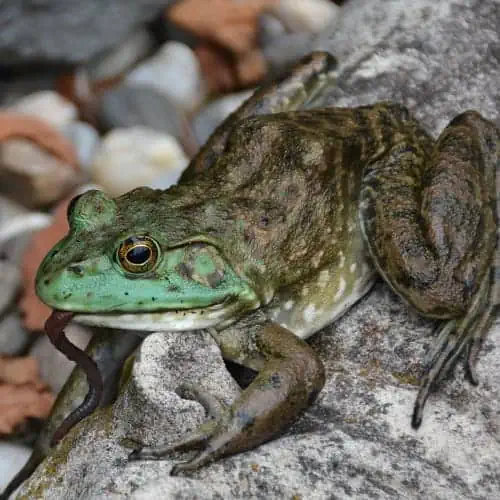
If your wildlife or ornamental pond has a few croaking visitors, you may be wondering how they manage to sustain themselves. Frogs are known for being quite adaptable in terms of food availability, but one thing that they do require is a protein-rich diet. Tadpoles, on the other hand, are able to benefit from a wider variety of food types, especially as their meal choices are directly related to their size and features. This means that, as they age and metamorphose, their food preferences change.
As a result, the amphibian diet is largely dependent on life stage. Mature frogs tend to be obligate carnivores, with some being surprisingly ferocious predators. As nature is dynamic, there are some species that are exceptions in that they may occasionally feed on plant material. For example, the Izecksohn’s Brazilian Tree Frog (Xenohyla truncata) is a frugivorous (fruit-eating) amphibian in adulthood. While it may benefit from the nutrients of tropical fruits, however, it will struggle to survive on an algal diet.
Although algae are rich in proteins, it would be counterproductive for adult frogs to feed on algal mats as their digestive organs are suited for meat consumption. That being said, algae play an extremely important role in the survival of frog species. Frogspawn, hatchlings, and tadpoles may not survive their first few days of life without algae.
Algal Consumption of Tadpoles
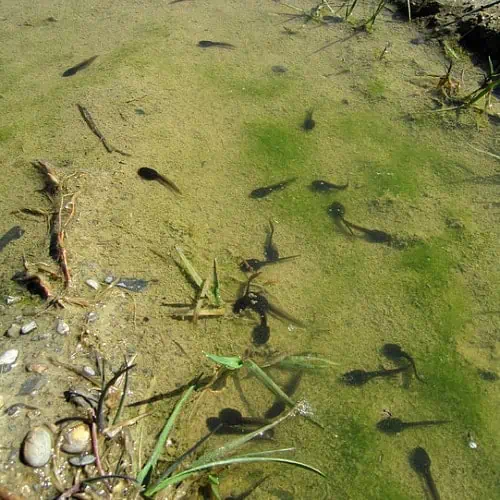
Tadpoles have extremely small mouths and only partially developed digestive organs during their first few weeks of life. Once they consume what’s left of their yolk sacs, they switch to a diet of primary producers. These include aquatic plants, algae, planktonic material, biofilm on submerged surfaces, and detritus particles. The availability of these food types depends on the properties of the tadpole microhabitat. Tadpole species and oral morphology also influence food selection.
Tadpoles typically consume two types of algae. Garden ponds usually contain suspended or planktonic (single-celled) algae, which can cause the water to become more green or cloudy when present in large quantities. These play a basal role in the food chain, determining which primary consumers are present and influencing their abundance and survival. Tadpoles will feed on this type most, especially as these are found throughout the water column and will often be carried to their shelter areas in the presence of a mild current.
Filamentous algae tend to grow along pond edges, approaching the surface. These can take on the appearance of fine strings or moss. In high-nutrient ponds, they can form slimy mats. Young tadpoles are less likely to eat this type as it may be tough for their small mouths to break up. Older tadpoles are more easily able to forage on the strings of filamentous algae.
Tadpoles as Biological Control for Algal Blooms
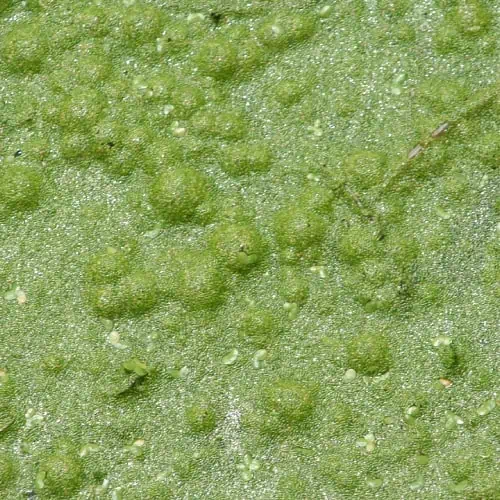
Ponds with healthy planktonic and filamentous algae concentrations can support a large number of tadpoles each year. In fact, tadpoles help regulate their growth, preventing potentially harmful algal blooms as optimal water parameters are met. They generally consume algal species that fall under the following genera: Chlamydomonas, Volvox, Klebsormidium, Spirogyra, Selenastrum, Ulothrix (all considered “green” algae). They may also consume some cyanobacteria (e.g. Anabaena, Microcystis), commonly referred to as “blue-green algae”, without harm.
When a significant influx of nutrients occurs and water temperatures are mild to warm, these algae begin to divide and spread at alarming rates. Without some form of control, they can rapidly colonize the pond, turning the water bright green or red. In this overabundant or “bloom” state, the algae prevent light penetration into the water column, stifling the growth of submerged plants. As the algal cells and aquatic plants die off, they can consume enough oxygen to create dead zones in the water.
Without the input of nutrient-rich material (such as run-off from fertilized soil or excess fish food), a healthy pond ecosystem is usually able to keep algal blooms at bay. The grazing activity of common frog and toad tadpoles, coupled with that of fish, insect larvae, and small crustaceans, balances out and resolves any subtle or gradual increases in algal concentration. Tadpole cultivation in wildlife ponds can keep the water remarkably clear. Regardless, even large tadpole populations may be unable to fend off blooms in the event of drastic nutrient accumulation.
Can Algae Be Harmful to Frogs and Tadpoles?

When blooms occur quickly enough to fully alter pond water properties, breeding frogs, eggs, and tadpoles can become affected too. No amount of grazing can remove the hundreds of microscopic algal particles that occur in every single drop of water. Algal blooms, especially that of blue-green algae, produce toxins that can quickly kill off aquatic organisms. This means that young tadpoles, not yet equipped with lungs, are especially vulnerable.
Fertile frogs in search of healthy pond ecosystems will instinctively stay away from algal blooms as their eggs will require oxygenated water and light. If you’d like to attract them to your pond, you must cultivate a frog-friendly ecosystem. Algae would of course have to be present, but in controlled numbers. Self-sustaining frog populations in the form of naturally occurring tadpoles, reduced input of excess nutrients from external sources, the presence of floating plants, and frequent pond maintenance (in the case of ornamental ponds) are just some ways to keep your pond system healthy.
Effect of High-Quality Algae on Tadpole Growth
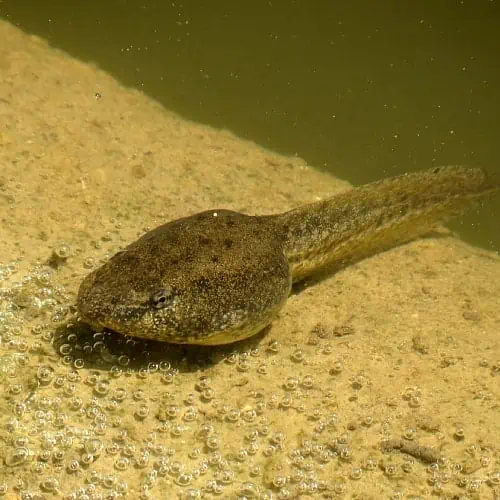
Tadpole diet significantly affects their growth rate. Some studies have shown that tadpoles fed with high-quality green algae (i.e. protein-rich species) tend to develop at a quicker pace. This explains why wild tadpoles may exhibit selectiveness while foraging for food. Those that grow larger and quicker develop a competitive edge in their microhabitats and are more likely to survive into froglets.
This can sometimes come at a cost to frog species that are less selective when it comes to algal type. The presence of rapidly growing bullfrog tadpoles, prone to being invasive and capable of quickly decimating filamentous algae, leaves less for non-aggressive native tadpole species. Additionally, when predators lurk in areas with higher-quality algae, tadpoles may avoid those areas and settle for lower-quality algae.
Can You Force a Frog to Eat Algae?

Wild frogs are unlikely to take up algae in any form, but domestically reared varieties that are accustomed to being raised in tanks may develop a taste for it. Algae in its processed form, such as pellets or wafers, are sometimes fed to indoor frogs. Note that this must not be their main source of nutrients. Moreover, they should never be forced to consume them as a substitute for fresh or frozen forms of live food. Algae is an unsuitable replacement for crickets, bloodworms, mealworms, and other protein-rich sources for frogs.
Feeding Tadpoles with Algae Wafers
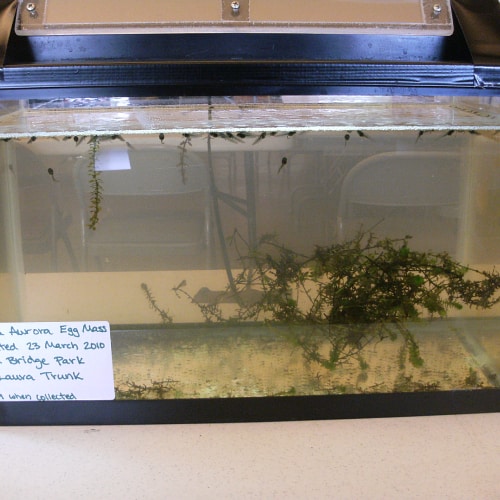
While algae wafers are unappetizing to frogs, tadpoles reared in tanks will happily devour them. In fact, they are a great way to encourage tadpoles to survive off of a natural diet. Other algae-based products that can serve as a great source of nutrients for tadpoles include seaweed meal, algae flakes, and spirulina discs. More safe types of food to feed tank-reared tadpoles are listed here.
Tadpoles in outdoor wildlife and ornamental ponds do not need to receive algal supplements. Even puddles that form during the rainy season might be suitable breeding grounds as they will have ideal properties for tadpole survival. Over time, these puddles will sustain micro-ecosystems with an assortment of primary producers, including planktonic algae!


Tell me how to get rid of frogs. My new pond seems to attract every frog in the state of Virgina and beyond. And now they are mating. My little goldfish and guppies are no more, thanks to the frogs.
I want the fish; I don’t need to hear frogs or have them mating every night by the score.